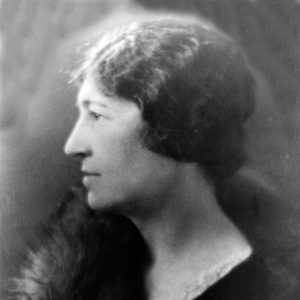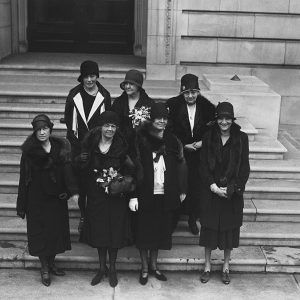calsfoundation@cals.org
Pearl Oldfield (1876–1962)
aka: Fannie Pearl Peden Oldfield
In 1929, Fannie Pearl Peden Oldfield became the first woman from Arkansas elected to the U.S. House of Representatives, where she served from January 9, 1929, to March 3, 1931. While a member of the House of Representatives, Oldfield introduced twenty-eight bills, served on three House committees, and spoke in Congress on three occasions.
Pearl Peden, daughter of John Peden and Amanda Hill Peden, was born on a farm near Cotton Plant (Woodruff County) on December 2, 1876. She attended Cotton Plant Grammar School and Batesville Public School. In 1891, Peden enrolled in Arkansas College (now Lyon College) in Batesville (Independence County) but withdrew before finishing a degree. In June 1901, she married William Allen Oldfield. The couple had no children. In 1908, when William Oldfield was elected to the U.S. House of Representatives from Arkansas’s Second Congressional District, he and his wife relocated to Washington DC. Representative William Oldfield served in the House for twenty years before his death on November 19, 1928.
Congressman Oldfield’s death created a new situation in Arkansas politics. For the first time, his death left two vacancies in Congress, the remaining months of his term in the Seventieth Congress and the term to which he had just been elected two weeks prior to his death. This was the first time in Arkansas history that a representative died while Congress was still in session and after he had been elected to a subsequent term.
On December 7, the Arkansas Democrat reported that the State Central Committee had decided against holding a primary to determine who would be the candidate and named Pearl Oldfield as the nominee for both terms. Speaking in support of the plan to nominate Pearl Oldfield, Gus Jones, a Newport (Jackson County) attorney, said he wanted the committee to “honor the memory of such an outstanding man as Bill Oldfield by nominating his dear, sweet wife.”
Following Oldfield’s nomination by the Democratic Party, many considered her election to be secure. The Arkansas Democrat reported that her election was “regarded as a certainty” and that “her nomination is equivalent to election.” Oldfield’s only challenge in the election was R. W. Tucker, a Democrat, who entered the race as an independent. Tucker believed that there should have been a Democratic primary to determine the candidate for the full term. His argument in challenging Oldfield for the full term was centered on the fact that Oldfield did not want the full term. She was quoted as saying, “No, I would rather not have had it, but they, Mr. Oldfield’s friends, have fought his battle for so many years and it is their wish that I should carry on, I cannot decline.”
Oldfield took office on January 9, 1929, as the nation faced the Great Depression and as Arkansas faced a massive drought. One of the three times Oldfield spoke on the House floor concerned the drought conditions in Arkansas. She argued in support of a $15,000,000 appropriations bill to supply food to the draught-stricken areas, saying, “The situation is distressing and most grave, with cold, sickness, and actual starvation present in many sections.” Oldfield spoke in the House two other times; one concerned the death of Congressman Otis T. Wingo from Arkansas’s Fourth Congressional District, and the other was her announcement that she would not run for an additional term in office.
While in office, Oldfield introduced twenty-eight bills. Of these twenty-eight bills, four bills relating to bridge construction were passed into law during her term in office. Oldfield also served on three committees: the Committee on Coinage, the Committee on Expenditure in the Executive Department, and the Committee on Public Buildings and Grounds.
Upon Oldfield’s retirement from the House, Representative Wall Doxey spoke of her, saying, “I have learned to appreciate her splendid work and to regard her judgment most highly. In all things I have found her to be diligent, painstaking, and broad-minded. Graciousness, culture, and refinement were always manifested by her.”
Oldfield’s own opinions about her role in Congress reflected her desire to honor her husband and carry out his congressional assignment, but she in no way saw it as an entry into the political world that should progress beyond what the men in power asked of her. In an article concerning her position in Congress, she was quoted as saying, “I shall advance no strange or exceptional feminine governmental ideas, as I entertain none. I believe that a government, if properly administered in behalf of our husbands, or sons, our fathers and our brothers, is equally safe and sound for our women.”
Following her congressional service, Oldfield made her home in Washington DC for the remainder of her life. There is no record of public service following her congressional service.
Pearl Oldfield died on April 12, 1962, after suffering a heart attack. She is buried beside her husband at Oaklawn Cemetery in Batesville (Independence County).
For additional information:
Chamberlin, Hope. A Minority of Members. New York: Praeger, 1973.
Harp, Deborah. “Pearl Peden Oldfield.” Independence County Chronicle 18 (October 1976): 31–36.
Obituary of Pearl Oldfield. Arkansas Gazette. April 14, 1962, p. 7A.
“Pearl Peden Oldfield.” In Biographical Directory of the United States Congress, 1774–1996. Washington DC: U.S. Government Printing Office, 1996. Online at http://bioguide.congress.gov/scripts/biodisplay.pl?index=O000061 (accessed August 19, 2023).
Lindley Shedd
University of Arkansas, Fayetteville
 Pearl Oldfield
Pearl Oldfield  U.S. Congresswomen, 1929
U.S. Congresswomen, 1929 




Comments
No comments on this entry yet.